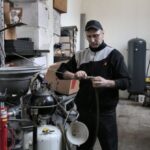Hydraulic systems are widely used in various industries due to their efficiency and reliability in powering machinery and equipment. However, like any mechanical system, hydraulic systems are prone to experiencing issues that can disrupt their performance. Understanding common problems that occur in hydraulic systems and knowing how to fix them is crucial for ensuring smooth operations and preventing costly downtime.
Leaking Seals
One of the most frequent issues that occur in hydraulic systems is leaking seals. Seals are essential components that prevent hydraulic fluid from leaking out of the system. Over time, seals can wear out due to constant pressure and temperature fluctuations, leading to leaks. Leaking seals can result in a drop in system pressure, reduced efficiency, and potential damage to other components.
To fix leaking seals, the affected seals need to be identified and replaced. It is essential to use high-quality replacement seals that are compatible with the hydraulic fluid and system requirements. Regular inspection and maintenance of seals can help prevent leaks and ensure the proper functioning of the hydraulic system.
Clogged Filters
Another common issue in hydraulic systems is clogged filters. Hydraulic filters are designed to remove contaminants such as dirt, debris, and particles from the hydraulic fluid to prevent damage to system components. When filters become clogged, they restrict the flow of hydraulic fluid, leading to decreased performance and potential damage to the system.
To address clogged filters, the filters need to be inspected and replaced if necessary. Regularly changing filters and using high-quality filters can help prevent clogs and ensure the cleanliness of the hydraulic fluid. Additionally, implementing a routine maintenance schedule that includes filter checks can help identify potential issues early on and prevent costly repairs.
Air in the System
Air can enter the hydraulic system through various means, such as leaks, improper bleeding, or inadequate fluid levels. When air becomes trapped in the system, it can cause issues such as spongy brakes, reduced system efficiency, and noise during operation. Removing air from the system is essential for maintaining optimal performance and preventing damage to components.
To address air in the hydraulic system, bleeding the system is necessary to remove trapped air bubbles. This process involves opening the bleed valves and allowing the air to escape while ensuring the hydraulic fluid levels are topped up. Properly bleeding the system can restore system functionality and prevent further issues caused by air entrapment.
Contaminated Fluid
Contaminated hydraulic fluid can lead to a host of problems in hydraulic systems, including decreased performance, component wear, and system malfunctions. Contaminants such as dirt, moisture, and particles can degrade the quality of the hydraulic fluid and compromise the system’s efficiency.
To fix contaminated fluid, the hydraulic fluid needs to be drained and replaced with clean, high-quality fluid. Additionally, flushing the system and cleaning components can help remove any remaining contaminants and prevent future issues. Regularly monitoring the condition of the hydraulic fluid and implementing a maintenance schedule for fluid changes can help prevent contamination and ensure the longevity of the hydraulic system.
Conclusion
In conclusion, understanding common issues that occur in hydraulic systems and knowing how to fix them is essential for maintaining optimal performance and prolonging the lifespan of hydraulic systems. By addressing issues such as leaking seals, clogged filters, air in the system, and contaminated fluid promptly, operators can prevent costly downtime and repairs. Implementing regular maintenance practices, such as inspections, fluid changes, and component checks, can help identify potential issues early on and ensure the reliable operation of hydraulic systems. By staying proactive and addressing issues promptly, operators can maximize the efficiency and longevity of their hydraulic systems.





